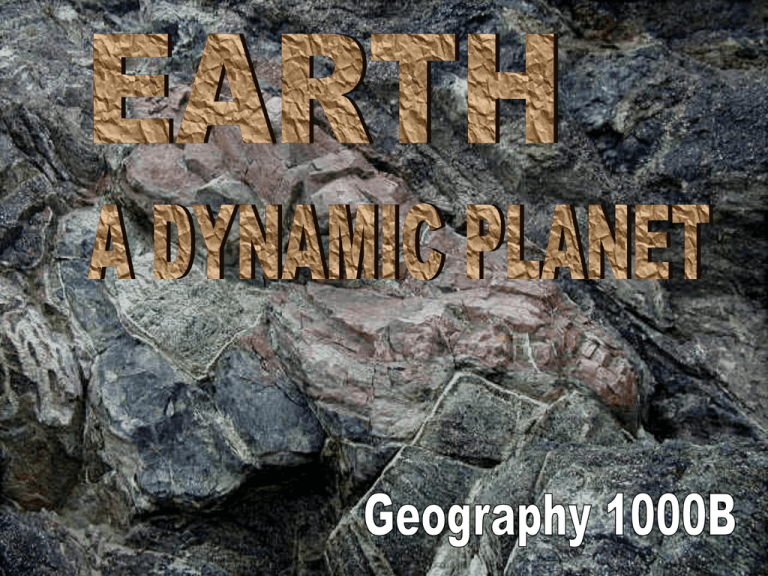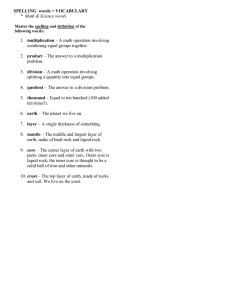Document 16069462
advertisement

‘SIDE VIEW’ 100,000 ly ‘TOP VIEW’ Solar System on outside of Orion Arm (25,000 light years from centre) Nebula (dust cloud) hypothesis Basis: observations of other systems 1. 2. 3. 4. 5. Collision or dying star in Milky Way? exploded Nebula (cloud of dust and gas) results H and He condense into Sun Disk of matter (many elements) around sun Disk slowly accretes into clumps (planetesimals) 6. planetesimals planetoids planets (including Earth) and satellites Eons, Eras, Periods and Epochs Superposition: youngest rocks superimposed on older rocks “Relative time” Dating by radioactive isotopes Half-life: time for ½ of unstable isotopes to decay “Absolute time” Uniformitarianism: “The same physical processes active in the environment today have been operating throughout geologic time” Hutton (1795), Lyell (1830) Red ovals indicate major extinction events The Earth in cross-section Upper mantle and lithosphere ISOSTASY Elevation of tectonic plates determined by density/thickness Mountain masses displace mantle material Isostatic adjustment due to loss of mass by erosion Deformation from sediment load Mineral A natural, inorganic compound with a specific chemical formula and a crystalline structure Examples silicates (quartz, feldspar, clay minerals), oxides (eg., hematite) carbonates (eg., calcite) An assemblage of minerals bound together • Igneous (solidify & crystallize from molten magma) • Sedimentary (settling & cementation) • Metamorphic (altered under pressure) • from magma (molten rock beneath the surface) • intrusive or extrusive (from lava) Laccolith Sill Dike Batholith plutons Existing rock or organic material is digested by weathering, picked up by erosion, moved by transportation, and deposited at river, beach and ocean sites. Lithification follows (cementation, compaction and hardening) Laid down in horizontally-layered beds Conglomerate Sandstone Siltstone Shale Limestone Coal largest clasts sand cemented together derived from silt mud/clay compacted into rock calcium carbonate, bones and shells cemented or precipitated in ocean waters ancient plant remains compacted into rock note the shells Any type of rock is transformed, under pressure and increased temperature Harder and resistant to weathering Produced from any rock type by: •Compressional forces due to plate collisions •Regional and contact metamorphism Shale Slate Granite Gneiss Basalt Schist Limestone, dolomite Marble Sandstone Quartzite Crustal Movements •Continents are adrift due to convection currents in the asthenosphere •Mantle movements result in plate migration •225 M BP: Pangaea Continents Adrift Fossil Record (plant and animal) Distribution of marsupials vs. placentals Age of mid-oceanic ridge magnetic stripes Age and thickness of oceanic crust Subduction zones “Ring of fire” Mid-oceanic ridge magnetic stripes See: http://www.scotese.com/sfsanim.htm (animation) Divergent Boundaries (constructional) Convergent Boundaries (destructional) Transform Fault Boundaries URL: http://pubs.usgs.gov/publications/text/Vigil.html Source: USGS Earthquakes and Volcanoes




